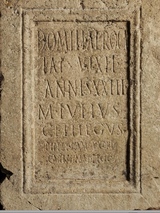Description: Grey limestone base,
w:
0.62 x h:
0.86 x d:
0.62, with panels on all four sides
Text: Inscribed within the panel on one face, which is worn; lines 6-7 more lightly cut.
Letters: Line 1: 0.07-0.08; Line 2: 0.06-0.07; Line 3: 0.06; Line 4: 0.055-0.06; Line 5: 0.045-0.055; Line 6: 0.035; Line 7: 0.025-0.03.
Date: Mid-second century CE (lettering, nomenclature)
Findspot:
Lepcis Magna: unknown
Original location: Unknown
Last recorded location:
Removed in 1819 from Africa to the British Museum, and thence to
Virginia Water, Surrey,
together with 310a and one block of 342; presented
by H.M. The Queen in 1961 to the Ure Museum, University of Reading,
2005.8.14
6: THIYSSAAE IRT, 1952; Philyssam Cormack, 1960; Several other readings have been recorded Kruschwitz, 2008
English translation
Translation by: J. M. Reynolds
To Domitia Rogata; she lived for twenty-three years. Marcus Julius Cethegus had (scil. this) made for Thiyssae (reading uncertain), a very dear wife.
English translation
Translation source: Kruschwitz, 2008
To Domitia Rogata. She lived twenty-three years. Marcus Iulius Cethegus Phelyssam had this made for his most beloved wife.
Bibliography: Delaporte, 1836 18, Rawlins, 1866 , whence CIL VIII, 1881, 19, and p.2289; mentioned, Hodder, 1903 50, Chambers, 1955 50; IRT, 1952, 693, whence IRT, 2009, 693; rediscovered Cormack, 1960 , whence AE 1962.97, EDH 016597; republished Kruschwitz, 2008 , whence AE 2008.1616,


